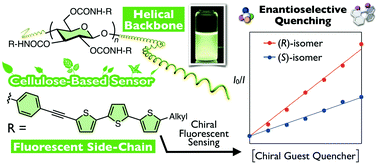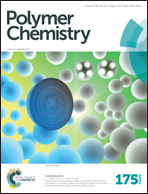Chiral fluorescent sensors based on cellulose derivatives bearing terthienyl pendants†
Abstract
Chiral fluorescent sensors were designed and synthesized from naturally occurring optically active cellulose, in which a terthienyl moiety was used as a fluorescent signaling unit, and their chiral recognition abilities were investigated on the basis of an enantioselective fluorescence response to aromatic nitro compounds as quenchers. A cellulose phenylcarbamate derivative (Ce-1b) exhibited an apparent enantioselectivity for various types of aromatic nitro compounds containing either central or axial chirality. Considering the fact that a corresponding monosaccharide derivative showed almost no enantioselectivity, the chiral recognition ability of the cellulose-based fluorescence sensor is attributed to its regular higher-order structures, probably a one-handed helical conformation. The resolution ability of Ce-1b as a chiral stationary phase for high-performance liquid chromatography was basically higher than that of the previously reported cellulose tris(phenylcarbamate), revealing that the terthienyl-based pendant provides attractive chiral recognition sites along the helical backbone as well as the fluorescent functionality.


 Please wait while we load your content...
Please wait while we load your content...